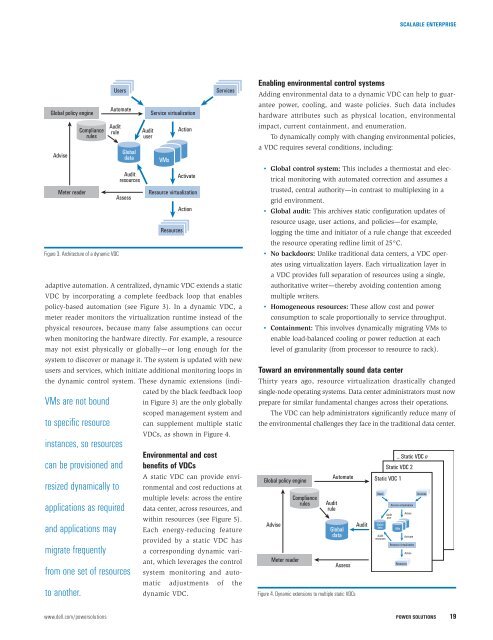Dell Power Solutions
Dell Power Solutions
Dell Power Solutions
- No tags were found...
Create successful ePaper yourself
Turn your PDF publications into a flip-book with our unique Google optimized e-Paper software.
SCALABLE ENTERPRISEGlobal policy engineAdviseMeter readerCompliancerulesUsersAuditruleFigure 3. Architecture of a dynamic VDCAutomateService virtualizationadaptive automation. A centralized, dynamic VDC extends a staticVDC by incorporating a complete feedback loop that enablespolicy-based automation (see Figure 3). In a dynamic VDC, ameter reader monitors the virtualization runtime instead of thephysical resources, because many false assumptions can occurwhen monitoring the hardware directly. For example, a resourcemay not exist physically or globally—or long enough for thesystem to discover or manage it. The system is updated with newusers and services, which initiate additional monitoring loops inthe dynamic control system. These dynamic extensions (indicatedby the black feedback loopVMs are not bound in Figure 3) are the only globallyscoped management system andto specific resource can supplement multiple staticVDCs, as shown in Figure 4.instances, so resourcescan be provisioned andresized dynamically toGlobaldataAuditresourcesAssessapplications as requiredand applications maymigrate frequentlyfrom one set of resourcesto another.AudituserVMsActionActivateResource virtualizationResourcesActionEnvironmental and costbenefits of VDCsServicesA static VDC can provide environmentaland cost reductions atmultiple levels: across the entiredata center, across resources, andwithin resources (see Figure 5).Each energy-reducing featureprovided by a static VDC hasa corresponding dynamic variant,which leverages the controlsystem monitoring and automaticadjustments of thedynamic VDC.Enabling environmental control systemsAdding environmental data to a dynamic VDC can help to guaranteepower, cooling, and waste policies. Such data includeshardware attributes such as physical location, environmentalimpact, current containment, and enumeration.To dynamically comply with changing environmental policies,a VDC requires several conditions, including:• Global control system: This includes a thermostat and electricalmonitoring with automated correction and assumes atrusted, central authority—in contrast to multiplexing in agrid environment.• Global audit: This archives static configuration updates ofresource usage, user actions, and policies—for example,logging the time and initiator of a rule change that exceededthe resource operating redline limit of 25°C.• No backdoors: Unlike traditional data centers, a VDC operatesusing virtualization layers. Each virtualization layer ina VDC provides full separation of resources using a single,authoritative writer—thereby avoiding contention amongmultiple writers.• Homogeneous resources: These allow cost and powerconsumption to scale proportionally to service throughput.• Containment: This involves dynamically migrating VMs toenable load-balanced cooling or power reduction at eachlevel of granularity (from processor to resource to rack).Toward an environmentally sound data centerThirty years ago, resource virtualization drastically changedsingle-node operating systems. Data center administrators must nowprepare for similar fundamental changes across their operations.The VDC can help administrators significantly reduce many ofthe environmental challenges they face in the traditional data center.Global policy engineAdviseMeter readerCompliancerulesAuditruleAutomateGlobaldataAssessFigure 4. Dynamic extensions to multiple static VDCsAuditUsersGlobaldataAuditresources… Static VDC nStatic VDC 2Static VDC 1AudituserService virtualizationVMsActionActivateResource virtualizationResourcesActionServiceswww.dell.com/powersolutions POWER SOLUTIONS 19








